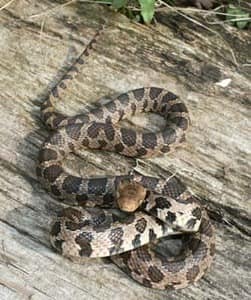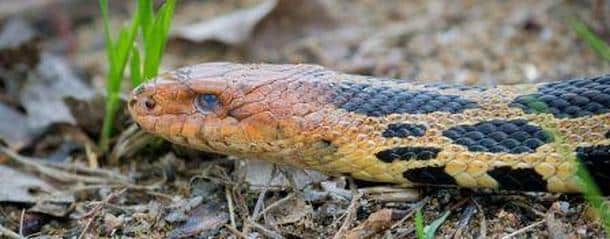Fox SnakePantherophis vulpinus / Pantherophis gloydi |

Custom Search
|
Since their ranges don't overlap, their habitat preferences are also different, the western fox snake inhabits woods, forests edges, open forests, prairies, pastures, dunes, fields and farmlands. While the eastern fox snake prefers marshes and wet meadows.
These are non-venomous colubrid snakes and pose no threat to humans, still they are needlessly killed by many people who mistake them for the venomous massasauga rattlesnake (Sistrurus catenatus) which shares their range and is somewhat similar in appearance. The fox snake is primarily active during the day in the spring and fall, but may become active at night during the summer to avoid the day high temperatures. They are mostly terrestrial snakes but nevertheless they are good climbers and swimmers. The fox snake ground color ranges from gray, yellowish, greenish brown, or tan, covered with larger, dark brown blotches on the back and smaller blotches on the sides. Their belly is usually yellow, marked with a black checkered pattern. Their head may sometimes be somewhat orange in color, which might cause people to misidentify them as the venomous copperhead snake. Fox snakes are a medium-sized species with an elongated, slender body covered with lightly keeled scales. It can reach 3 to 5 feet (91 to 152 cm) in length, with males being larger than females.
 Fox snake Fox snake
Just like many other harmless non-venomous snakes, fox snakes sometimes vibrate their tails in the ground debris mimicking rattlesnakes.
However this defensive behavior, gets many of them killed by humans, when they are mistaken for those more dangerous snakes. Fox snakes are usually docile and not aggressive snakes but they may still bite when harassed. They also produce a musky odor similar to that of the red fox when handled, hence their common name "fox snake". Like many other snake species that live in the northern regions of north america, fox snakes will brumate during winter months. They often will occupy suitable dens used also by other fox snakes and even other species. Their natural predators include hawks, coyotes and foxes. Taxonomy / Species These snakes were up until recently considered to be subspecies of Elaphe vulpina, the eastern fox snake (Elaphe vulpina gloydi) and the western fox snake (Elaphe vulpina vulpina). In 2002 scientists considered that North American rat snakes should be separated from the Old World rat snakes belonging to the Elaphe genus, and Pantherophis was resurrected to include them. This taxonomic change created much controversy and involved all other rat snakes like the black rat snake also known as the western rat snake. Western Foxsnake (Pantherophis vulpinus - Baird and Girard, 1853) - Found in Michigan, Wisconsin, Illinois, Minnesota, Iowa, northwestern Indiana, Nebraska, Missouri and South Dakota. Eastern Foxsnake (Pantherophis gloydi - Conant, 1940) - This species has a very restricted range and is found only in Ontario in Canada and Michigan and Ohio in the US, near Lakes Huron and Erie. Diet / Feeding Since their ranges don't overlap, their diet is somewhat different from one another. The eastern fox snake diet is for the most part composed of meadow voles, although on occasion they will take other prey. While the the western fox snake feeds on a variety of small mammals including rats, mice, chipmunks, even small rabbits, birds eggs. Sometimes birds or other animals are also eaten by them. The young fox snakes may also eat frogs and insects. These powerful snakes will usually kill their prey using constriction, but smaller animals may just be eaten on the spot without the use of constriction. Reproduction The mating season occurs in the late spring into early summer soon after the fox snakes emerge from overwintering dens where they brumate. Females lay an average clutch of 8 to 25 snake eggs in mid summer, usually in humus or rotted wood or a under a log. The eggs typically hatch in early fall, and the hatchlings are relatively large roughly 1 feet in length. The young snakes are very similar in appearance to adult snakes. Conservation / Threats Like other non-venomous snakes, fox snakes are commonly mistaken for venomous snake species and often indiscriminately killed, when they are in fact harmless and beneficial to humans. The eastern fox snake is listed as threatened in the state of Michigan and in the Canadian province of Ontario. The western fox snake is considered endangered in the state of Missouri mostly due to wetland drainage and prairie loss. The major threats to fox snakes are habitat loss, illegal collection and road kill. Their population trend is currently under study by biologists, although the western fox snake population is considered stable.
|
Scientific Classification |
© 2014 Snake Facts About Us | Privacy Policy | Contact




